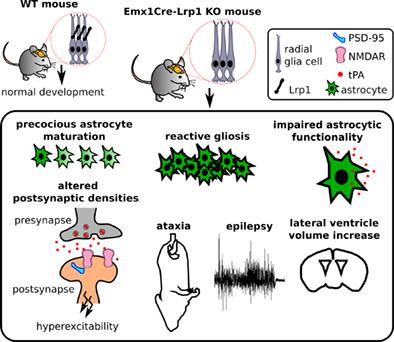Our official English website, www.x-mol.net, welcomes your feedback! (Note: you will need to create a separate account there.)
Lipoprotein receptor loss in forebrain radial glia results in neurological deficits and severe seizures.
Glia ( IF 6.2 ) Pub Date : 2020-06-24 , DOI: 10.1002/glia.23869 Ewa E Bres 1, 2 , Dina Safina 1, 2 , Julia Müller 3 , Peter Bedner 3 , Honghong Yang 4 , Xavier Helluy 4, 5 , Olena Shchyglo 4 , Stephan Jansen 4 , Melanie D Mark 6 , Alexander Esser 7 , Christian Steinhäuser 3 , Stefan Herlitze 8 , Claus U Pietrzik 9 , Swetlana Sirko 10, 11 , Denise Manahan-Vaughan 4 , Andreas Faissner 1
Glia ( IF 6.2 ) Pub Date : 2020-06-24 , DOI: 10.1002/glia.23869 Ewa E Bres 1, 2 , Dina Safina 1, 2 , Julia Müller 3 , Peter Bedner 3 , Honghong Yang 4 , Xavier Helluy 4, 5 , Olena Shchyglo 4 , Stephan Jansen 4 , Melanie D Mark 6 , Alexander Esser 7 , Christian Steinhäuser 3 , Stefan Herlitze 8 , Claus U Pietrzik 9 , Swetlana Sirko 10, 11 , Denise Manahan-Vaughan 4 , Andreas Faissner 1
Affiliation

|
The Alzheimer disease‐associated multifunctional low‐density lipoprotein receptor‐related protein‐1 is expressed in the brain. Recent studies uncovered a role of this receptor for the appropriate functioning of neural stem cells, oligodendrocytes, and neurons. The constitutive knock‐out (KO) of the receptor is embryonically lethal. To unravel the receptors' role in the developing brain we generated a mouse mutant by specifically targeting radial glia stem cells of the dorsal telencephalon. The low‐density lipoprotein receptor‐related protein‐1 lineage‐restricted KO female and male mice, in contrast to available models, developed a severe neurological phenotype with generalized seizures during early postnatal development. The mechanism leading to a buildup of hyperexcitability and emergence of seizures was traced to a failure in adequate astrocyte development and deteriorated postsynaptic density integrity. The detected impairments in the astrocytic lineage: precocious maturation, reactive gliosis, abolished tissue plasminogen activator uptake, and loss of functionality emphasize the importance of this glial cell type for synaptic signaling in the developing brain. Together, the obtained results highlight the relevance of astrocytic low‐density lipoprotein receptor‐related protein‐1 for glutamatergic signaling in the context of neuron–glia interactions and stage this receptor as a contributing factor for epilepsy.
中文翻译:

前脑放射状胶质细胞中的脂蛋白受体丢失会导致神经功能障碍和严重癫痫发作。
阿尔茨海默病相关的多功能低密度脂蛋白受体相关蛋白-1 在大脑中表达。最近的研究揭示了这种受体对神经干细胞、少突胶质细胞和神经元的适当功能的作用。受体的组成型敲除 (KO) 是胚胎致死的。为了阐明受体在发育中的大脑中的作用,我们通过专门针对背侧端脑的径向神经胶质干细胞生成了小鼠突变体。与现有模型相比,低密度脂蛋白受体相关蛋白 1 谱系限制性 KO 雌性和雄性小鼠在出生后早期发育期间出现严重的神经系统表型,伴有全身性癫痫发作。导致过度兴奋和癫痫发作的机制可以追溯到星形胶质细胞发育不足和突触后密度完整性恶化。在星形胶质细胞谱系中检测到的损伤:早熟、反应性神经胶质增生、组织纤溶酶原激活剂吸收消失和功能丧失强调了这种神经胶质细胞类型对发育中大脑中突触信号传导的重要性。总之,获得的结果突出了星形胶质细胞低密度脂蛋白受体相关蛋白-1 在神经元-神经胶质相互作用的背景下与谷氨酸能信号传导的相关性,并将该受体作为癫痫的一个促成因素。反应性神经胶质增生、消除组织纤溶酶原激活剂摄取和功能丧失强调了这种神经胶质细胞类型对于发育中大脑中突触信号传导的重要性。总之,获得的结果突出了星形胶质细胞低密度脂蛋白受体相关蛋白-1 在神经元-神经胶质相互作用的背景下与谷氨酸能信号传导的相关性,并将该受体作为癫痫的一个促成因素。反应性神经胶质增生、消除组织纤溶酶原激活剂摄取和功能丧失强调了这种神经胶质细胞类型对于发育中大脑中突触信号传导的重要性。总之,获得的结果突出了星形胶质细胞低密度脂蛋白受体相关蛋白-1 在神经元-神经胶质相互作用的背景下与谷氨酸能信号传导的相关性,并将该受体作为癫痫的一个促成因素。
更新日期:2020-06-24
中文翻译:

前脑放射状胶质细胞中的脂蛋白受体丢失会导致神经功能障碍和严重癫痫发作。
阿尔茨海默病相关的多功能低密度脂蛋白受体相关蛋白-1 在大脑中表达。最近的研究揭示了这种受体对神经干细胞、少突胶质细胞和神经元的适当功能的作用。受体的组成型敲除 (KO) 是胚胎致死的。为了阐明受体在发育中的大脑中的作用,我们通过专门针对背侧端脑的径向神经胶质干细胞生成了小鼠突变体。与现有模型相比,低密度脂蛋白受体相关蛋白 1 谱系限制性 KO 雌性和雄性小鼠在出生后早期发育期间出现严重的神经系统表型,伴有全身性癫痫发作。导致过度兴奋和癫痫发作的机制可以追溯到星形胶质细胞发育不足和突触后密度完整性恶化。在星形胶质细胞谱系中检测到的损伤:早熟、反应性神经胶质增生、组织纤溶酶原激活剂吸收消失和功能丧失强调了这种神经胶质细胞类型对发育中大脑中突触信号传导的重要性。总之,获得的结果突出了星形胶质细胞低密度脂蛋白受体相关蛋白-1 在神经元-神经胶质相互作用的背景下与谷氨酸能信号传导的相关性,并将该受体作为癫痫的一个促成因素。反应性神经胶质增生、消除组织纤溶酶原激活剂摄取和功能丧失强调了这种神经胶质细胞类型对于发育中大脑中突触信号传导的重要性。总之,获得的结果突出了星形胶质细胞低密度脂蛋白受体相关蛋白-1 在神经元-神经胶质相互作用的背景下与谷氨酸能信号传导的相关性,并将该受体作为癫痫的一个促成因素。反应性神经胶质增生、消除组织纤溶酶原激活剂摄取和功能丧失强调了这种神经胶质细胞类型对于发育中大脑中突触信号传导的重要性。总之,获得的结果突出了星形胶质细胞低密度脂蛋白受体相关蛋白-1 在神经元-神经胶质相互作用的背景下与谷氨酸能信号传导的相关性,并将该受体作为癫痫的一个促成因素。


























 京公网安备 11010802027423号
京公网安备 11010802027423号